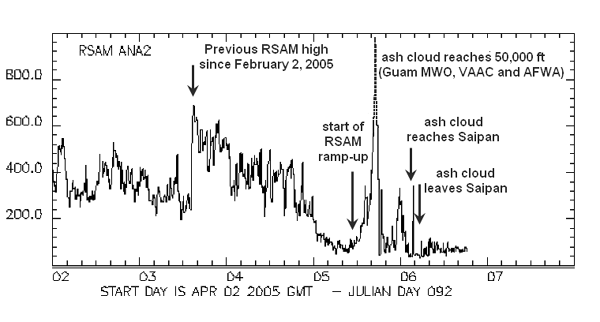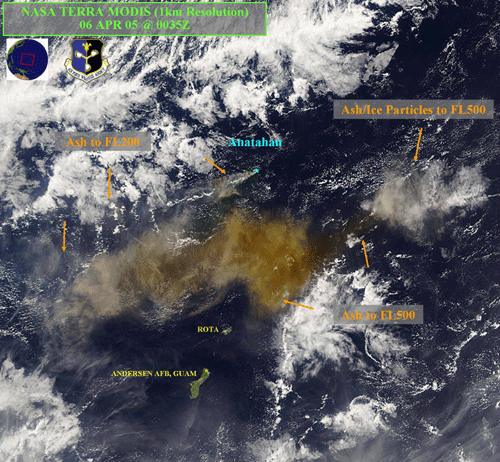NSF Program Announcement Research Activities MARGINS-NSF Awards Event Response Policy Data Policy Data Server Post-Doctoral Fellowships Related Websites
|
||||||||||||||||||||
Summary of the 5 April 2005
Anatahan Eruption to 50,000 ft.
Randall A. White
Geophysicist
U.S. Geological Survey
Menlo Park, California
A short summary of the lead up and eruption effects. All times in UTC; add 10 hours for local time.
After a month long hiatus in this year's eruption at anatahan, the seismicity and the eruption picked up on March 14. The ramp up in seismicity included numerous small explosions that likely reopened the clogged vent. After apparently shutting down again from March 17-21, the eruption ramped up again with similar small explosions likely reopening the vent. After shutting down yet again on the 25th, the eruption ramped up a third time on March 28 in the same fashion as the previous two episodes. This time tremor amplitudes declined slowly for several days then rose rapidly over a few hours to a new high for the last two months on April 3, again after numerous small explosions. That episode declined over two days. About 1000 UT yesterday April 5, the tremor amplitude then began increasing slowly. There were NO PRECURSORY signals, neither explosions nor any other recognizable seismic precursor this time. By 1600 the tremor amplitude had not yet reached the high of April 3, which had not put ash to levels higher that 15,000 ft. But about this time the Guam Meteorological Weather Office had observed an ash rising to 30,000 ft on their radar. They advised the VAAC who in turn advised me. At this time I initiated a call down, beginning with the Air Force Weather Agency (Jenifer Piatt) who were particularly helpful. They were immediately able to verify the ash to 30,000 ft with satellite imagery. And shortly after 1700 UT they called back advising that the ash had reached 50,000 ft.
The peak of the eruption lasted no more than an hour or so. John Ewert later estimated that an ash volume of about 50,000 m3 of ash were erupted during this interval, equivalent to a large VEI 3. The RSAM tremor amplitude seems to correlate very well in amplitude and time with the satellite data on the plume height. The eruption then dropped off very rapidly over just an hour or so to near background level, remained there for about 5 hours and, after a small 3 hour-long burp of tremor, has remained at near background level to the current time.
The Governor of CNMI and the EMO Director called me at 7 PM PDT regarding the eruption and the ash cloud. At that time a "huge black cloud" was blocking out the sunlight at Saipan, "making it like during a total eclipse." They were worried about long-term consequences. I told them the eruption had essentially ended over 6 hours earlier. I also told them that the ash cloud was passing them to the west and I thought the ash fall thickness on Saipan would not exceed 1/8 inch, would almost certainly not exceed 1/4 inch, and that people should just stay indoors for an hour or two until it passed. I told them that I would check with a USGS geologist expert in ash fall just to be sure. I immediately called John Ewert for his opinion. From the eruption height and duration, he estimated the 50,000 m3 of ash erupted in the episode and from that he guessed that the eruption would not drop more than a few millimeters on Saipan, Rota and Tinian but said that he would run an eruption model and to verify that guess. I passed John's opinion on to the EMO Director and told him that we would have John's modeling results in about an hour. Sure enough an hour later, John (on vacation at the time, by the way) called back that the results indicated a light dusting up to 2 mm maximum. I called EMO with those results, and was informed that the sky was already clearing, that ash fall was just a light dusting. Good job John.
We have been in somewhat dire straights over the last several weeks to the current time. We are down to a single short-period seismometer on Anatahan, down from our original three seismometers and two microphones. Mugabe station (ANAM seismometer and ANMM microphone) was likely destroyed by bombs in early February during the first phase of this year's eruption. The one station still operating, ANA2, has frequent transmission dropouts and so has caused several false alarms on the RSAM trigger system. Andy Lockhart has just now revised the alarm system to work with a single sensor, instead of the normal minimum of two, and to not trigger on events (and dropouts) but just trigger on tremor levels. It's primitive but the best we can do until its safe enough to visit the island. As soon as the volcano demonstrates some reliable quiescence for a month or so, Andy has volunteered to return to the island and upgrade the system to its original status.
 |
Annotated RSAM figure for the last 5 days in UT time. The dashed line at crunch time is my interpretation of the maximum RSAM level arrived at via the low-gain data from the same station. |
 |
An annotated Terra Modis image of the ash plume at 0035 UT April 6. Thanks to AFWA. |



